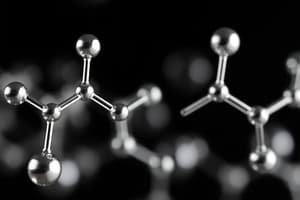Podcast
Questions and Answers
Which functional group is characterized by a carbon atom double bonded to an oxygen atom at the end of a carbon chain?
Which functional group is characterized by a carbon atom double bonded to an oxygen atom at the end of a carbon chain?
- Ketone
- Aldehyde (correct)
- Hydroxyl
- Carboxyl
What type of isomerism is defined by molecules having the same molecular formula but different spatial arrangements?
What type of isomerism is defined by molecules having the same molecular formula but different spatial arrangements?
- Diastereomerism
- Stereoisomerism (correct)
- Structural Isomerism
- Enantiomerism
Which type of reaction involves the addition of atoms across a multiple bond, resulting in the formation of a single bond?
Which type of reaction involves the addition of atoms across a multiple bond, resulting in the formation of a single bond?
- Substitution
- Addition (correct)
- Condensation
- Elimination
Which of the following is NOT a characteristic feature of organic compounds?
Which of the following is NOT a characteristic feature of organic compounds?
Which of the following examples represents a compound with a functional group containing a carbonyl group?
Which of the following examples represents a compound with a functional group containing a carbonyl group?
What type of organic compound contains a hydroxyl group (-OH)?
What type of organic compound contains a hydroxyl group (-OH)?
What type of hybridization is exhibited by carbon atoms in an alkane?
What type of hybridization is exhibited by carbon atoms in an alkane?
Which of these reactions involves the combination of two molecules to form a larger molecule, along with the release of a smaller molecule like water?
Which of these reactions involves the combination of two molecules to form a larger molecule, along with the release of a smaller molecule like water?
Which of the following is NOT a key aspect of IUPAC nomenclature?
Which of the following is NOT a key aspect of IUPAC nomenclature?
What is the primary purpose of Infrared (IR) spectroscopy in organic chemistry?
What is the primary purpose of Infrared (IR) spectroscopy in organic chemistry?
Which of the following statements best describes the relationship between chirality and optical activity?
Which of the following statements best describes the relationship between chirality and optical activity?
Which of the following is NOT a common application of organic chemistry in other scientific fields?
Which of the following is NOT a common application of organic chemistry in other scientific fields?
What does the term "in-fixes" refer to in the context of IUPAC nomenclature?
What does the term "in-fixes" refer to in the context of IUPAC nomenclature?
Flashcards
Organic Chemistry
Organic Chemistry
The study of carbon-containing compounds.
Covalent Bonds
Covalent Bonds
Bonds formed by sharing electrons between atoms.
Hybridization
Hybridization
The mixing of atomic orbitals in carbon to form new shapes.
Functional Groups
Functional Groups
Signup and view all the flashcards
Isomerism
Isomerism
Signup and view all the flashcards
Aldehydes
Aldehydes
Signup and view all the flashcards
Addition Reactions
Addition Reactions
Signup and view all the flashcards
Condensation Reactions
Condensation Reactions
Signup and view all the flashcards
IUPAC Nomenclature
IUPAC Nomenclature
Signup and view all the flashcards
Chirality
Chirality
Signup and view all the flashcards
Optical Activity
Optical Activity
Signup and view all the flashcards
IR Spectroscopy
IR Spectroscopy
Signup and view all the flashcards
NMR Spectroscopy
NMR Spectroscopy
Signup and view all the flashcards
Study Notes
Introduction to Organic Chemistry
- Organic chemistry is the study of carbon-containing compounds.
- Carbon's unique ability to form four covalent bonds allows for a vast diversity of molecules.
- These molecules range from simple hydrocarbons to complex biomolecules like proteins and DNA.
- Organic compounds are essential for life processes.
Structure and Bonding
- Covalent Bonds: Carbon forms covalent bonds with other atoms, sharing electrons.
- Hybridization: Carbon atoms often exhibit different hybridization states (sp3, sp2, sp) affecting molecular shape and properties.
- Functional Groups: Specific groups of atoms within molecules that determine chemical reactivity. Examples include hydroxyl (-OH), carboxyl (-COOH), amino (-NH2), and carbonyl.
- Isomerism: Molecules with the same molecular formula but different structural arrangements.
- Structural isomers differ in the bonding sequence.
- Stereoisomers have the same bonding but different spatial arrangement.
- Enantiomers are non-superimposable mirror images.
- Diastereomers are stereoisomers that are not enantiomers.
- Shapes of Organic Molecules: Molecules can be linear, branched, or ring-shaped.
Classification of Organic Compounds
- Hydrocarbons: Compounds containing only carbon and hydrogen.
- Alkanes (single bonds).
- Alkenes (double bonds).
- Alkynes (triple bonds).
- Aromatic hydrocarbons (rings with delocalized electrons).
- Alcohols: Contain hydroxyl (-OH) groups.
- Ethers: Contain oxygen connected to two carbon atoms.
- Aldehydes: Contain a carbonyl group (C=O) at the end of a carbon chain.
- Ketones: Contain a carbonyl group (C=O) within a carbon chain.
- Carboxylic acids: Contain carboxyl (-COOH) groups.
- Amines: Contain amine (-NH2) groups.
Reactions of Organic Compounds
- Addition Reactions: Reactions where atoms are added across a multiple bond (double or triple).
- Substitution Reactions: Reactions where an atom or group of atoms replaces another atom or group of atoms on a molecule.
- Elimination Reactions: Reactions where atoms or groups of atoms are removed from a molecule.
- These reactions can lead to the formation of double or triple bonds.
- Condensation Reactions: Reactions where two molecules combine to form a larger molecule with the loss of a small molecule (often water).
- Oxidation-Reduction Reactions: Processes involving the gain or loss of electrons by molecules, common in biological systems.
IUPAC Nomenclature
- A systematic method for naming organic compounds based on their structure.
- Prefixes, suffixes, and in-fixes describe the number of carbon atoms, functional groups, and other structural features.
Stereochemistry
- Chirality: Molecules that exist in non-superimposable mirror image forms.
- Optical Activity: The ability of chiral molecules to rotate plane-polarized light.
Spectroscopy
- Techniques used to determine the structure of organic compounds using electromagnetic radiation absorption.
- IR Spectroscopy: Absorptions of IR light are related to vibrational frequencies within the molecules.
- NMR (Nuclear Magnetic Resonance) Spectroscopy: Detects the magnetic properties of atomic nuclei and provides information about the environment of specific atoms in the molecule.
Importance in Physical Science
- Organic compounds play a crucial role in various fields such as materials science, pharmaceuticals, and polymers.
- Understanding organic chemistry is fundamental to advancements in these and other applications.
Studying That Suits You
Use AI to generate personalized quizzes and flashcards to suit your learning preferences.




